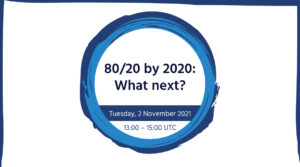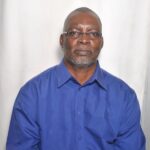
In 2010, the Africa peering, and interconnection community set a goal to locally exchange 80 percent of the Internet traffic consumed in Africa, with only 20 percent routed from outside the continent.
The November 2021 Virtual Peering Session sought to explore how much of this objective has been achieved, what are some of the impediments and what new targets the community can set moving forward.
Before the session started Patrick Gilmore, founder of the North Carolina Internet Exchange (NC-IX), paid tribute to Susan Forney, a trail-blazing engineer whose work spanned various communities including the African Peering and Interconnection Forum (AfPIF). He said Susan worked as a network engineer in some of the largest networks in the world and was remembered as a kind manager and a mentor. Susan was also a loved mother, wife, friend, and colleague who will be dearly missed.

Amreesh Phokeer, Internet Measurement and Data Expert at the Internet Society kicked the session off with a recap of the 80/20 report released by the Internet Society in July 2021. What are the key challenges in Africa and why have many countries struggled to reach the 80/20 goal?
The session sponsors included FLEXOPTIX, Microsoft, Facebook, Nap Africa, Paix, Internet Society, DE-CIX, and MainOne.

According to Michael Kende, a former economist with the Internet Society and the author of the report Moving Toward an Interconnected Africa: The 80/20 Initiative, two in-depth reports were done in Kenya and Nigeria over the past decade on the benefits of increased local traffic, one in 2012 and an update in 2020. The study also undertook a bird’s eye view of IXPs in Africa as well as case studies from 6 countries in each sub-region of the continent.
“The benefits are first, cost savings from not using expensive IP transit, secondly latency is much better, the content loads much faster with fewer jitters because it loads locally,” explained Kende.
“This has been shown to increase the usage of the content which increases the revenues of the ISPs that in many cases are selling data packages and is a win-win for everyone when local IXPs are used,” he said.
In 2012, Kenya and Nigeria were localizing about 30 percent of the content which increased to 70 percent by 2020 bringing the countries closer to the goal.
According to Kende, ecosystem development followed three key stages of development. “Stage one is mostly local ISPs connecting and exchanging mostly local content,” he explained. “This is followed by the international content where the CDNs and regional ISPs start connecting to the IXP to access that traffic.”
Stage three will see the IXP approach the 80 percent local traffic mark where the ecosystem requires all local ISPs to join, and local content hosted abroad to be relocated in-country.
According to Kende, connected networks could be even a better metric to measure the development of the IXP as opposed to the amount of traffic.
The reason being that “when there is a lot of traffic exchanged between two parties, across the IXPs, it is often moved to a private interconnect. That traffic will not be visible or measured but the networks will still stay connected to the IXP,” he explained.
Only four IXPs on the continent located in South Africa, Kenya, and Nigeria, count more than 50 connected members and these are the countries that achieved at least 70 percent localized traffic or above.
“There’s a strong correlation between the number of members and the amount of traffic,” he explained. “We looked at some numbers courtesy of NAPAfrica and the Uganda IXP and you would expect that the more connections there are to an IXP the more traffic as everyone brings the traffic.”
However, Kende says the numbers showed that it’s not just the total amount of traffic that goes up, but the average amount of traffic per member. This illustrates the generative growth where every new member that connects raises the average of all the others by generating more traffic.
This is a strong relationship and suggests that a focus on the number of connected networks could be a very important way to increase the amount of traffic.
“Reforming the telecommunications regulations so that internet service providers and mobile network operators can increase the number of connections is another way,” explained Kende. “Increased competition leads to more choice, reduction in prices and more consumers will go online and exchange traffic.”
It also emerged that content, particularly from international content delivery networks, CDNs like Facebook, Google, Akamai is important in deploying caches in a country to deliver traffic. This improves latency and increases traffic; the more the traffic is localized, the more people use it.
The conditions at the IXP are also important. If the IXP limits members to just Internet Service Providers (ISPs), it sets an upper band in the number of ISPs that can be connected.
“Many point to mandatory multilateral peering agreements, for example, explained Kende. “While it ensures that everyone who joins peers with one another, it dissuades some from joining because they’d like to choose who to peer with.”
Putting the IXP in a carrier -neutral data center which is the case in South Africa, Kenya and Nigeria also helps to increase choice, bring in more members and make it easier for them to connect with others collocated in the same facility.
Aside from NAPAfrica in South Africa which is free and has the highest number of members, there isn’t a distinct relationship between the cost of joining the IXP and the number of members. Some have very low costs with very few members, while the Kenya IXP and Nigerian IXP have median costs with high members.
This does not imply that increasing the price of joining will not have any impact, but that the savings from being in the IXP and not using international traffic far outweigh the benefits.
Local content from users, governments, educational networks, and enterprises is also critical for the development of the ecosystem. These should be hosted locally as it lowers the latency and requires the building of data centers that can help host and support the ecosystem.
Some of the recommendations from the report include increasing the impact of reforms on the market to increase the number of ISPs and ensure choice and low prices for consumers.
There is also a need to look at long-distance connectivity to ensure there is intra-connectivity within countries as well as between several countries. This ensures everyone can join, bring in data and fill in the caches at a low cost.
“In addition, there is a need to address content regulations so people can set up data centers and fill them with local and international content that’s all exchanged at the local IXP,” explained Kende.
“This entails liberalizing the IXP policies, creating awareness and capacity building to include more members that will translate to more traffic exchanged and help move the country and the region closer to the 80/20 goal,” he said.
Paulos Nyirenda is the Chairperson of the Malawi Internet Exchange that was founded in 2008 in partnership with KTH – Royal Institute of Technology of Sweden who joined the discussion as one of the panelists.

According to Nyirenda, more than 82 percent of the prefixes allocated to Malawi are announced on the Malawi Internet Exchange while the remaining 17.5 percent are end-user networks.
“If we actually look at the actual IP addresses allocated in Malawi, we find we reach around 99 percent of them that announce on Malawi IX,” he said.
Nyirenda says some of the factors that have helped the IX gain traction include close collaboration among members as well as the contribution of resources like equipment and capacity building from ISOC.
“We also acknowledge the contribution from our colleagues at PCH for their DNS service and recently the availability of caches for CDNs including the Google cache,” he explained. “We now also have an Akamai cache and have just installed a Facebook FNA cache.”
Christian Muhirwa, CEO of the Broadband Systems Corporation in Rwanda explained that the country’s Internet Exchange, set up in 2004, has grown from a few megabytes to several gigabytes exchanged.

This was driven by a concerted effort by operators who wanted to exchange local traffic meant for local consumption.
The ecosystem is now in phase two which has been about getting content networks to peer in-country. This has had an impact on the traffic being exchanged, although it later became fragmented as each operator started engaging different CDNs individually.
“We have about 12 operators peering at the IXP, but the content networks are usually not peering because we the operators have not chosen a unified approach,” explained Christian. “This is one approach we need to change so we are able to attract even more members to the exchange point.”

Jean-Baptiste Millogo, Executive Director of the Burkina Faso Internet Exchange narrated how the IXP was set up in 2015 as an initiative by the government and Internet firms in the private sector.
“At that time our major objective was to reduce the international costs because IP transit is high for landlocked countries,” he explained. At the onset, the IX only had three members and registered around 1MB daily.
“It was very little, and we worked to build the community and bring in more members and now we are 15 and traffic is at 20GB daily,” he explained.
During the session, members were asked in a poll what the key challenges were to reach the 80/20 goal.
Most respondents (51 percent) stated that lack of infrastructure was the biggest hurdle while 42 percent said high connectivity costs. 32 percent stated that the biggest challenge was a closed market while 26 percent stated lack of proper policies.
With many countries yet to achieve the 80/20 target, the key starting point for the panel discussion was what priorities IXPs should focus on regarding developing their local and regional markets.

Michael Kende indicated that some of the initiatives rested in the hands of regulators who are expected to appreciate the benefits of competition in the market and opening to content providers.
“IXPs need to step up awareness creation, conduct surveys and reports that create a better understanding of the ecosystem to bring in more members,” he said.
Kyle Spencer, Executive Director at the Uganda Internet eXchange Point (UIXP) and Co-Coordinator, the African IXP Association (Af-IX) asked the panelists whether connected networks could be the next target going forward as opposed to traffic targets.
According to Christian Muhirwa, there is a need to grow connected networks that are diversified. “Most of the operators in Rwanda are connected but there is also a need to have CDNs connected,” he said.
“The hindrance to this is transit costs particularly for landlocked countries,” he explained. “The cost is a key factor to members connecting at the regional IXs and they are also important in bringing the content networks,” he said.
Christian further explained that there is a need to build more data centers to host operators who can be demanding in terms of expected quality of service.
Jean-Baptiste concurred that increasing the number of members would be one of the key interventions to driving success for the IX in Burkina Faso.
“Currently we have around 15 networks connecting to the checkpoint, but we have around 26 ASNs registered in Burkina Faso,” he said. “This means we need to bring in more members to increase our traffic.”
In addition to this, there is a need to ensure world-class carrier networks go to the data centers. CDN providers expect facilities that will meet certain thresholds in terms of technical capacity.
“Countries can also adopt a hub-model where Burkina Faso, for example, can be a hub for Niger, Mali, and Northern Ivory Coast,” explained Jean-Baptiste. “This creates an open door to bring in more CDNs and together with the improved technical capacity, will increase connections and traffic.”
Nyirenda from Malawi’s Internet Exchange cited capital as a major challenge in financing activities at the Malawi IXP.
“Malawi is also landlocked, and we have very high connectivity costs both internationally and on the national level,” he explained. “This is in terms of connecting CDNs at the IXP and it causes fragmentation as CDNs move from the exchange point to carriers.”
Another challenge identified is the lack of adequate local content. Currently a big portion of content from Malawi is hosted abroad and the country does not have a carrier-neutral data center. There are however initiatives including one by the World Bank to build a data center in the country.
Another challenge is the scarcity of data to better measure the development of the ecosystem. Now, it’s difficult for policy makers to give direction on how to grow the ecosystem because of a lack of data.
Kyle Spencer shared the experience at the Uganda Internet Exchange where there are about 30 networks connected to the exchange, which helped bring CDNs since they can’t do individual deployments for 30 networks.
“This helps attract the CDNs to the exchange,” he explained. “Because we have a reasonable permissive policy that has enabled that reality, it has created a kind of interconnection ecosystem that helps create demand for the carrier-neutral DC that just came into the market.”
The second poll asked attendees about the high-priority areas for IXP development in the African region going forward.
Of those polled, 39 percent said more connected networks were a high priority followed by 22 percent that listed more traffic and financial sustainability as priorities while 17 percent said the presence of content delivery networks was the highest priority to IXP success.
Amreesh Phokeer stated that operators and members face a chicken and egg question; should IXPs invest in data centers first then beef up the IXP or establish the IXP first then attract networks, carrier-neutral data centers and other players.
According to Christian Muhirwa, as much as more connected networks are desirable, a key determinant is the content in those networks.
“In our case for instance we’ve got one operator sitting on a pile of caches on their network and not sharing it on the exchange point for whatever reasons,” he explains. “This operator is going to announce (at the IXP) network prefixes that don’t attract the most traffic.”
“We need to have content within those networks,” he said. “It’s common knowledge that most of our traffic in Africa goes or comes from CDNs that are not in Africa.”
According to Christian, data centers will come in when a vibrant hosting and network market is set up. Getting the exchange point to become as diverse as possible requires that the operators work to reduce terrestrial capacity connection charges.
Jean-Baptiste on the other hand believes that the first step towards success for the Burkina Faso IXP would be to have 100 percent of all local ASNs connected to the exchange point.
“This means we need to rebuild our community and support capacity building because the number of members connected is sometimes attributed to the peering and interconnections model,” he said.
“Here, for example, some of the community members come from the telecommunications traditional model and asking them to exchange data without billing can be a challenge,” he explained.
Michael Kende explained that the number of connected networks is good first because it increases the amount of traffic as localizing the traffic lowers the cost and increases local content.
“In the report, there are significant differences in the percentages of local traffic, and we do need more measurements,” he said.
“We could say something like let’s double the number of connected networks in the next three years which means everyone has a goal to achieve despite their stage of network development,” he said.